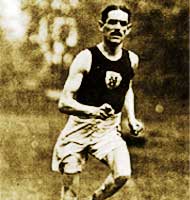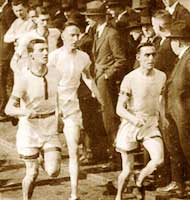ALFRED Shrubb’s vast personal experience, plus the knowledge he gained from working with leading coaches like Harry Andrews, led to him developing some innovative ideas about training and lifestyle for runners.
After arriving in the USA Shrubb was invited to coach the students of Harvard University and he would later take up a full-time post at Oxford Unversity back in England – spending eight years coaching some of the nation’s top athletes who were studying there.
Before taking on these coaching roles, Shrubb displayed his excellent grasp of the fundamentals of long-distance training when he had two books published, both acclaimed as forward-thinking, full of common sense and based on first-hand knowledge.
These books would be highly popular among runners and many years later would occasionally be referred to in athletics literature and on websites. Top runners like Paavo Nurmi, Johnny Miles and Roger Bannister are just three of the record breakers who have sung the praises of Shrubb’s words.
Shrubb’s first book would surface late in 1908 in the shape of a small hardback called Running and Cross-Country Running, published by Health and Strength Limited, of London. Rather than a Shrubb autobiography, it was a coaching manual, packed with Shrubb’s homespun tips on how to train and prepare for races of different distances, and how to stay fit and healthy. It may have been down to Shrubb’s well-known modesty, or perhaps due to his publishers’ specific wishes, but the book contains precious little anecdotal material. Over the years, however, it would come to be looked upon as a real gem by those interested in coaching methods and how they developed over the ages. It would also prove an inspirational piece of work to more than one quality runner to emerge over the first half of the 20th century.
Stretching to 12 chapters and 85 pages, Shrubb’s book sold for half a crown (2/6d) and featured a ‘Brief Word Sketch’ of the man himself, contributed by J.Murray. This chapter compensates for Shrubb’s modesty by calling him ‘probably the most extraordinary athlete the world has ever seen.’ Murray was clearly a big admirer: ‘He is wondrously beautiful in make. There is not much of him, it is true, but what there is of him is of the finest possible quality.’ Read in the modern era, this gushing prose seems almost embarrassing. Murray also manages to get the runner’s year of birth wrong, but these negative points aside, he paints a succinct pen picture of the runner and the man. Referring to Shrubb’s much-debated ‘ugly’ running style, he suggests that ‘future ages may possibly decide that Shrubb’s style is like the Venus of Milo, in that it was not invented in accordance with the canons, but, on the contrary, that it invented them.’ Many runners travel in a ‘prettier’ fashion, but none are so effective. ‘No other runner can point to such a career as his, ’ Murray concludes, ‘and it may well be questioned whether his career will ever be equalled. Walter George’s alone can be compared with it, and Shrubb has achieved the seemingly impossible by eclipsing even George’s fame.’
Then in Canada in 1909 came publication of Shrubb’s second book – which was basically a revamped version of his earlier coaching manual, aimed this time at the North American. Called ‘Long-Distance Running’, it was published by the Imperial News Company of Toronto and did a brisk trade. Instead of J.Murray’s word sketch, as per the 1908 London version, this time Shrubb’s ex-South London Harriers mentor Thomas Sinnott penned an introductory chapter. Like Murray, Sinnott found it necessary to paint a picture of Shrubb’s physical appearance: ‘He is a slim-built, slight and light little fellow. It must not be supposed, however, that Alfred Shrubb is a mere midget. He is neither a Sandow giant in stature nor a Daniel Lambert in build, but he is a mass of whipcord and muscle, stands 5ft.6ins. in height and weighs ordinarily when stripped 126 lbs. For the benefit of sentimental maidens who may be in danger of losing their hearts to this attractive all-conquering athlete, it may be as well to state that…Mr Shrubb took to himself a wife.


